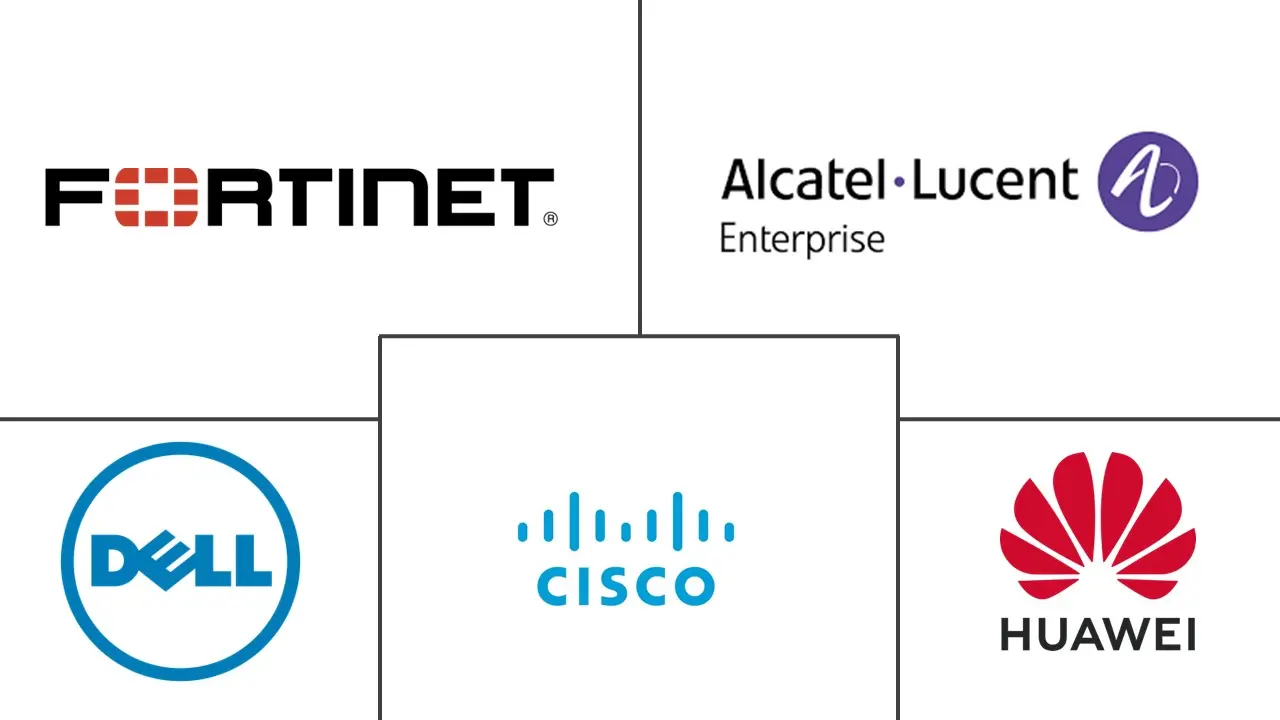Enterprise WLAN Market Size and Share
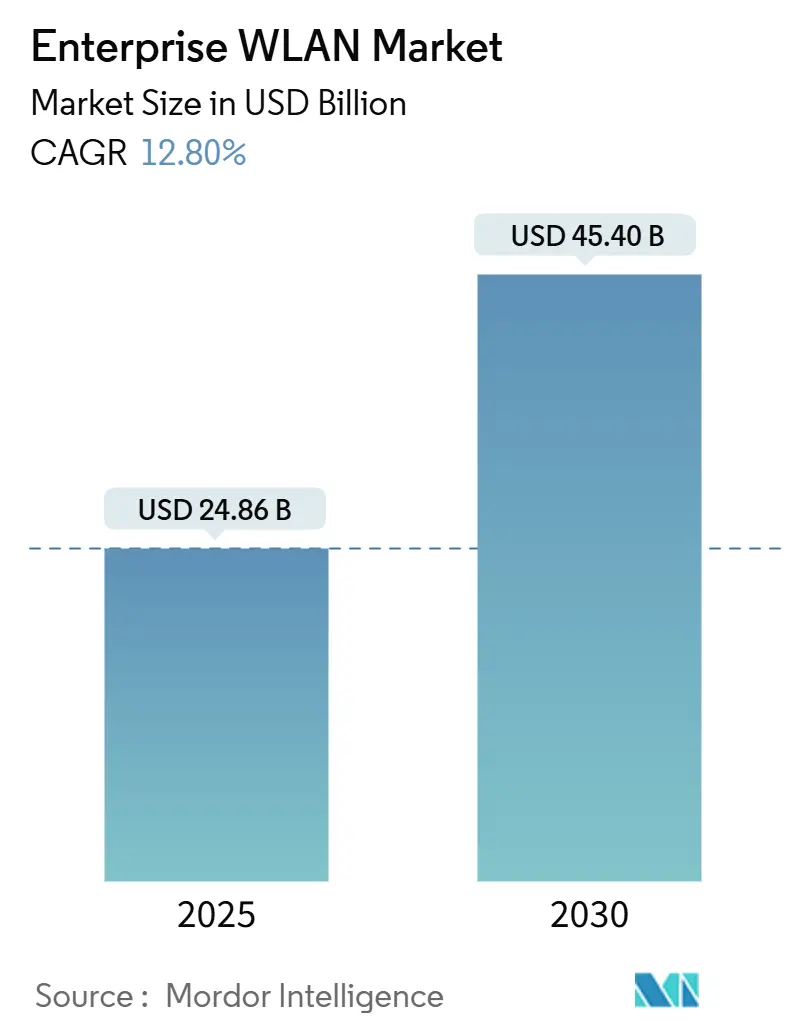
Enterprise WLAN Market Analysis by Mordor Intelligence
The enterprise WLAN market size stands at USD 24.86 billion in 2025 and is projected to reach USD 45.40 billion by 2030, reflecting a 12.8% CAGR for the forecast period. Earlier supply constraints have largely receded, and procurement budgets are shifting toward next-generation wireless infrastructure that supports hybrid work, high-density IoT, and latency-sensitive video workloads. The rapid move to Wi-Fi 6E—and the first wave of Wi-Fi 7 trials—expands usable spectrum into the 6 GHz band, enabling multigigabit throughput and deterministic latency that legacy Wi-Fi 5 networks cannot match.[1]Pierre de Vries, “Drivers and Barriers to Wi-Fi 7 Deployment,” Electronics Weekly, electronicsweekly.comNorth America captured 38.9% of 2024 revenue on the strength of deep IT investments and favorable spectrum policy, while Asia Pacific is the fastest-growing region as digital-first agendas gain momentum. Hardware remains the largest spending category, yet AI-driven management and security software is climbing faster as enterprises prioritize automation, observability, and zero-trust controls. Market consolidation—illustrated by HPE’s USD 14 billion bid for Juniper Networks—aims to assemble full-stack portfolios capable of challenging Cisco’s roughly 40% share, according to NetworkWorld, but antitrust scrutiny may reshape timelines.
Key Report Takeaways
- By component, hardware led with 61.2% revenue share in 2024; software is expanding at a 14.1% CAGR through 2030.
- By organization size, large enterprises held 58.0% of the enterprise WLAN market share in 2024, while SMEs recorded the highest projected CAGR at 12.8% to 2030.
- By end-user vertical, IT and Telecommunications accounted for 29.5% of the enterprise WLAN market size in 2024; healthcare is set to advance at a 13.6% CAGR through 2030.
- By deployment mode, on-premises solutions retained a 66.3% share in 2024, yet cloud-managed WLAN is climbing at a 14.4% CAGR to 2030.
- By geography, North America led with 38.9% revenue share in 2024; Asia Pacific is forecast to grow at a 13.5% CAGR over the same horizon.
Global Enterprise WLAN Market Trends and Insights
Drivers Impact Analysis
| Restraint | (~) % Impact on CAGR Forecast | Geographic Relevance | Impact Timeline |
|---|---|---|---|
| Chip-set supply-chain volatility | –1.8% | Global, sharper in emerging markets | Short term (≤2 years) |
| Skills gap in Wi-Fi design and security | –1.2% | Global, more pronounced in fast-growing economies | Medium term (2-4 years) |
| Enterprise private-5G substitution risk | –0.8% | Regional, intense in manufacturing, logistics, healthcare | Long term (≥4 years) |
| Rising cybersecurity insurance premiums | –0.5% | Global, larger burden in regulated industries | Medium term (2-4 years) |
| Source: Mordor Intelligence | |||
Surge in Wi-Fi 6/6E Upgrade Cycles Drives Performance Leap
- Opening 1,200 MHz of 6 GHz spectrum gives enterprises the first contiguous stretch of ultra-wide channels for multigigabit WLAN, and multi-link operation in Wi-Fi 7 boosts throughput while trimming latency. Video collaboration, immersive training, and AR-assisted maintenance demand such deterministic performance, prompting 40% of large organizations to bring forward refresh schedules. Indian regulators value the 6 GHz allocation at USD 4,030 billion in cumulative economic activity for 2024-2034, underscoring its macro impact.[2]Kevin Robinson, “Economic Value of the 6 GHz Band for Unlicensed Use in India,” Dynamic Spectrum Alliance, dynamicspectrumalliance.orgYet higher power budgets and POE++ switches are prerequisites, nudging buyers to coordinate access-layer and switching upgrades in tandem.
Hybrid Work Models Demand Network Transformation
Hybrid work is now standard practice, requiring seamless roaming, granular access control, and application-level QoS across offices and homes. Enterprises allocate an average of USD 115.7 million over three years for advanced wireless projects to enable unified user experiences, VPN-grade security, and analytics-driven capacity planning. Passpoint (IEEE 802.11u) simplifies secure onboarding for employees and guests, lowering help-desk tickets while tightening identity assurance. The enterprise WLAN market benefits as CIOs align network modernization with workplace flexibility mandates
IoT Density Drives Network Architecture Evolution
By 2030, commercial smart buildings alone will host a significant number of IoT devices, pushing WLAN designs toward tri-radio APs and dynamic segmentation that isolates critical systems. Zero-trust architectures verify every device and flow, and blockchain-based identity schemes add tamper-resistant logs for compliance-sensitive environments. Complementary use of private 5G for latency-critical AGVs and Wi-Fi 6 for indoor sensors creates hybrid fabrics, broadening the enterprise WLAN market addressable scope.
Cloud Management Transforms Operational Economics
Cloud-hosted WLAN controllers eliminate onsite hardware, unify multisite operations, and embed AI for anomaly detection. Mist AI from Juniper flags root-cause issues before users notice, shrinking mean-time-to-repair and cutting truck rolls, which resonates with lean IT teams. Forty-two percent of professionals admit they devote excessive hours to manual troubleshooting tasks, according to NetworkComputing. Shifting CAPEX to OPEX, plus continuous feature updates, sustains a double-digit growth clip for cloud-managed platforms.
Restraints Impact Analysis
| Restraint | (~) % Impact on CAGR Forecast | Geographic Relevance | Impact Timeline |
|---|---|---|---|
| Chip-set supply-chain volatility | –1.8% | Global, sharper in emerging markets | Short term (≤2 years) |
| Skills gap in Wi-Fi design and security | –1.2% | Global, more pronounced in fast-growing economies | Medium term (2-4 years) |
| Enterprise private-5G substitution risk | –0.8% | Regional, intense in manufacturing, logistics, healthcare | Long term (≥4 years) |
| Rising cybersecurity insurance premiums | –0.5% | Global, larger burden in regulated industries | Medium term (2-4 years) |
| Source: Mordor Intelligence | |||
Persistent Supply-Chain Disruptions Constrain Growth
Lead times for network ASICs stretch up to 52 weeks in some data-center SKUs, prompting buyers to postpone rollouts or adopt cloud alternatives that lessen hardware dependence. Vendors with diversified suppliers weather shortages better and capture displaced demand. Extreme Networks cites pandemic-era resilience that unlocked new sales in healthcare refits.
Cybersecurity Skills Gap Threatens Network Security
Ninety percent of breaches are tied partly to talent shortfalls, and wireless security expertise is especially scarce, according to Fortinet. Although Fortinet pledges to train one million specialists by 2026, 19% of enterprises already report a high risk of missing objectives due to a lack of skilled staff. AI-assisted policy engines help close gaps, but hiring lags remain a drag on enterprise WLAN market growth.
Segment Analysis
By Component: Hardware Dominates, Software Accelerates
Hardware contributed 61.2% of 2024 revenue, powered by demand for high-density Wi-Fi 6E access points that safeguard application performance in auditoriums, factories, and hospitals. Vendors bundle tri-radio designs, integrated IoT radios, and advanced RF analytics that justify premium price points. The enterprise WLAN market is now cycling through switch upgrades that supply 2.5 Gbps or 5 Gbps multigig Ethernet plus 90 W POE to drive next-generation APs. The software category, though smaller, is climbing at a 14.1% CAGR as AI-native cloud control, assurance analytics, and threat-centric micro-segmentation become indispensable. Mist AI and Cisco DNA Center illustrate how controller logic, network data lakes, and machine learning converge into single-pane experiences.
Access point firmware and license subscriptions convert once-periodic capital spending into recurring revenue, enticing investors and compressing refresh intervals. Meanwhile, professional and managed services flourish because organizations lack in-house RF planning and zero-trust design skills. Consultants orchestrate site surveys, spectrum audits, and compliance validation, adding stickiness to vendor ecosystems
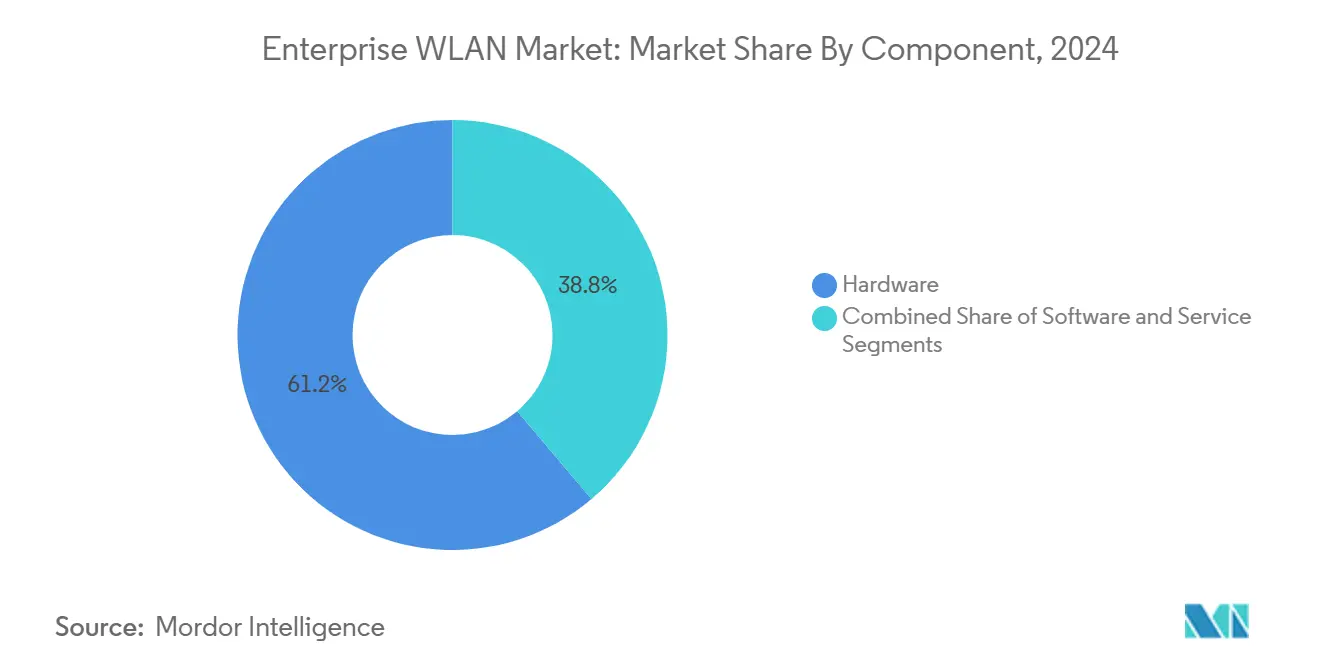
Note: Segment shares of all individual segments available upon report purchase
By Organization Size: Large Enterprises Lead, SMEs Accelerate
Large enterprises held 58.0% of the enterprise WLAN market share in 2024, reflecting multi-campus estates that demand scaled authentication, policy engines, and resiliency. SD-branch architectures feeding into SASE frameworks align well with Fortune 1000 security mandates. Yet SMEs post the strongest 12.8% CAGR, encouraged by subscription-based WLAN as a service that removes controller hardware and heavy upfront cost. Cloud onboarding and automated RF optimization free smaller IT teams from arcane CLI workflows, making enterprise-grade features accessible without hiring certified wireless engineers.
Vendors repackage enterprise functionality into tiered offerings that emphasize quick deployment, pay-as-you-grow licensing, and mobile-first dashboards. MSP channels bundle WLAN with broadband and VoIP, deepening penetration among retail, hospitality, and professional services. As talent shortages persist, SMEs turn to outsourced monitoring, driving a services layer that grows in lockstep with cloud-managed adoption.
By End-user Vertical: IT and Telecom Dominates, Healthcare Surges
The IT and Telecom sector accounts for 29.5% of the enterprise WLAN market size, acting as both a technology innovator and a showcase customer. Hyperscalers, colocation providers, and network operators rely on multitenant WLAN for visitor access, staging labs, and smart warehouse automation. Healthcare delivers the fastest 13.6% CAGR as hospitals digitize patient records, embrace telehealth, and deploy connected medical devices that require deterministic latency and strong isolation. Proposed HIPAA Security Rule updates place greater emphasis on encryption, access control, and continuous monitoring, triggering budget reallocations to WLAN refresh.
Retailers incorporate Wi-Fi analytics to map shopper paths and enable cashier-less checkout, while universities standardize next-gen Wi-Fi across dorms and classrooms to support e-learning platforms. Manufacturers invest in redundant WLAN meshes for AGVs and wireless programmable logic controllers, concluding that cabling impedes flexible retooling. Financial institutions seek branch transformation, deploying secure Wi-Fi for staff mobility and customer engagement while meeting stringent compliance.
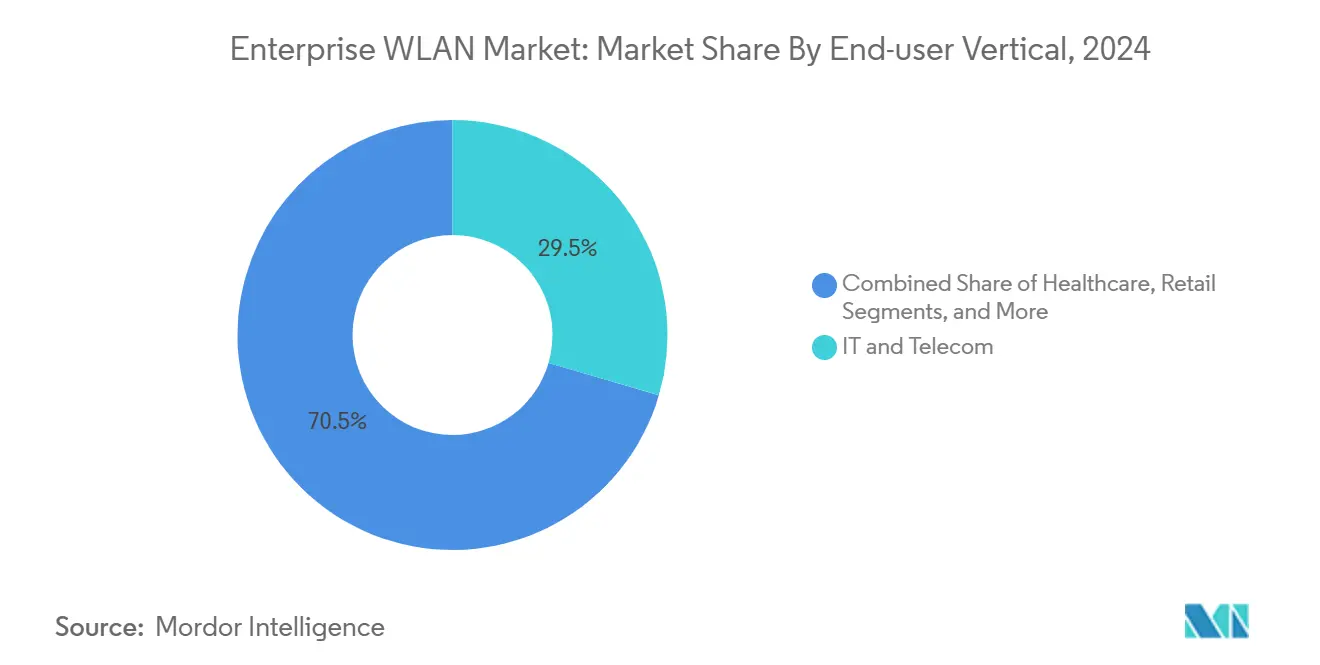
Note: Segment shares of all individual segments available upon report purchase
By Deployment Mode: On-premises Persists, Cloud Accelerates
On-premises models still account for 66.3% of deployments, favored by government, finance, and healthcare entities that keep data planes local for compliance. Locally hosted controllers provide deterministic control paths and facilitate custom RF tuning. Nonetheless, cloud-managed solutions are expanding at a 14.4% CAGR owing to elastic scale and rapid feature rollouts. The enterprise WLAN market increasingly adopts hybrid control, where critical campuses remain on-premises and distributed sites move to SaaS dashboards.
AI-supported assurance modules in the cloud aggregate telemetry across thousands of APs, producing baseline performance fingerprints and auto-generating remediation scripts. This autonomy shortens problem resolution cycles and frees engineers for strategic tasks. Support for API-first operations allows DevNet teams to integrate WLAN events into IT service management suites, aligning networking with broader DevOps pipelines.
Geography Analysis
North America generated the highest revenue with a 38.9% share in 2024, buoyed by FCC-backed 6 GHz allocations that created an estimated USD 870 billion in economic value during 2023-2024.[3]Telecom Advisory Services, “Economic Value of Wi-Fi Spectrum in the United States,” telecomadvisoryservices.com United States shipments swung sharply, down 30.6% year over year in Q2 2024, then rebounded 15.3% sequentially as backlogs cleared, according to InfotechLead. Federal broadband funding, smart-building incentives, and a vibrant managed services channel sustain spending across healthcare, education, and financial services.
Asia Pacific posts the fastest 13.5% CAGR between 2025 and 2030. China remains the biggest market, steered by industrial policies that favor digital factories and campus rollouts. India’s policy think tank values unlicensed 6 GHz at USD 4,030 billion in cumulative impact through 2034, further catalyzing enterprise WLAN market demand. ASEAN members expand manufacturing footprints and modernize airports, both requiring high-density Wi-Fi and zero-trust segmentation.
Europe shows mixed momentum. Shipments sank 22.3% year over year in Q2 2024 amid macro headwinds, then ticked up modestly in Q3 as inventory normalization progressed, according to InfotechLead. The European Vision for 6G Network Ecosystems prioritizes AI-native and integrated sensing features, and spectrum regulators push common frameworks to accelerate vendor innovation.[4]European 6G-IA Vision Working Group, “European Vision for the 6G Network Ecosystem,” 6g-ia.euThese initiatives will shape enterprise WLAN upgrades because interoperability between 5G-Advanced and Wi-Fi 7 is a design goal for campus environments.
The Middle East and Africa remain smaller but record double-digit growth as governments invest in smart cities. United Arab Emirates ministries deploy converged Wi-Fi/IoT networks in federal buildings, while South African retailers adopt cloud-managed WLAN to support omnichannel commerce. Latin America, starting from a low base, registered 235% year-over-year growth in Q3 2023 after supply bottlenecks eased and currency stability improved. The region’s hospitality and mining sectors show particular interest in AI-assisted WLAN for guest services and remote site connectivity.
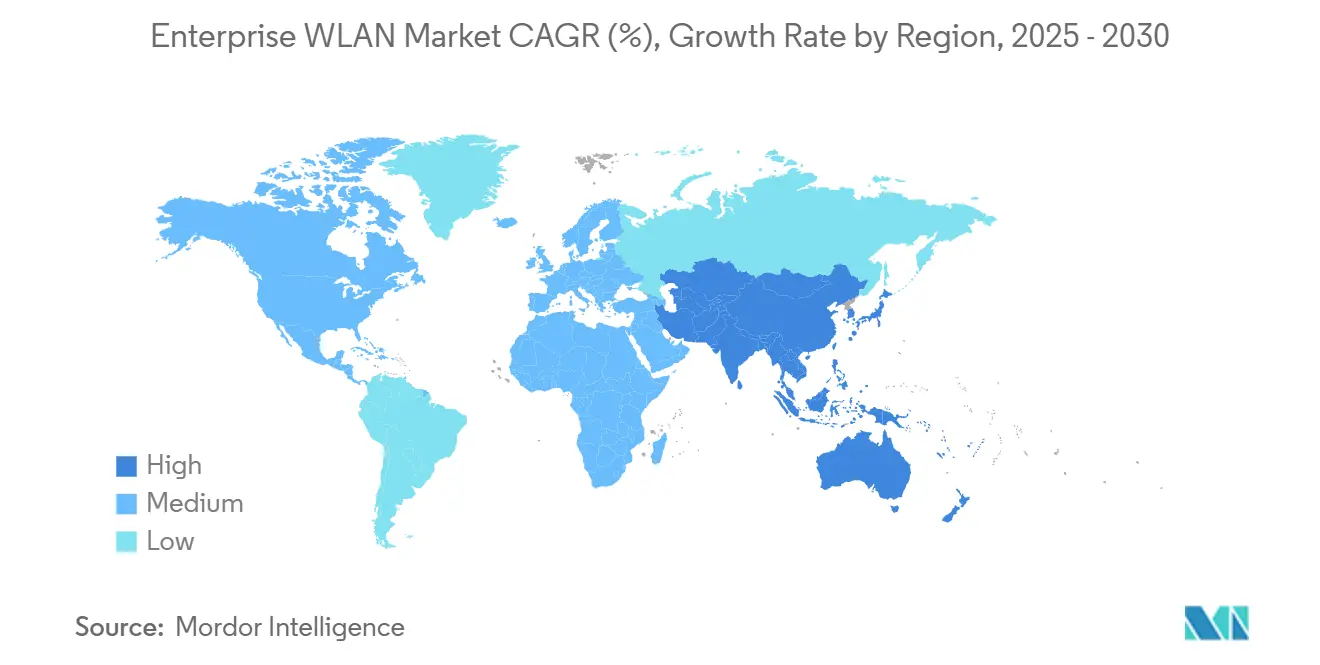
Competitive Landscape
Cisco maintains leadership with around 40% revenue share, yet revenue slipped 29.7% in Q2 2024 as backlog burn-down overshadowed new orders. HPE’s proposed USD 14 billion acquisition of Juniper Networks aims to fuse Aruba’s campus WLAN strength with Mist AI’s cloud automation. Regulators fear post-merger concentration could exceed 70% in the United States, and litigation threatens to delay integration. During the uncertainty, Extreme Networks positioned itself as a stable alternative, winning 164 deals above USD 1 million in FY 2024.
Product differentiation centers on AI-driven operations. Juniper’s Marvis virtual assistant processes telemetry to offer actionable insights, while Cisco embeds AI analytics inside the Catalyst Center. Fortinet unifies next-generation firewalls and Wi-Fi, creating a single security fabric that compares favorably in cyber insurance audits. HPE-Aruba leads in unified wired-wireless policy via ClearPass and EdgeConnect SD-WAN synergy.
White-space opportunities emerge in industry-specific packages: healthcare bundles that combine RTLS for medical assets, manufacturing kits tuned for Wi-Fi-based AGV handoffs, and education editions with cloud-native identity. Vendors also explore subscription tiers that add CBRS or private-5G radio modules, allowing campus operators to deploy converged networks under one license plan.
Early Wi-Fi 7 road-map visibility influences RFPs. Extreme has introduced AP4000 series units that handle 320 MHz channels with flexible power profiles, while Cisco’s Catalyst 9800E controller firmware already supports multi-link operation for select beta customers. Partners such as WWT compare vendor power budgets and heat dissipation to guide facilities teams on switch and cooling upgrades. Timely Wi-Fi 7 certification will become a land-grab moment for share shifts.
Enterprise WLAN Industry Leaders
-
Cisco Systems Inc.
-
Huawei Technologies Co. Ltd.
-
Alcatel Lucent Enterprises
-
Dell Inc.
-
Fortinet
- *Disclaimer: Major Players sorted in no particular order
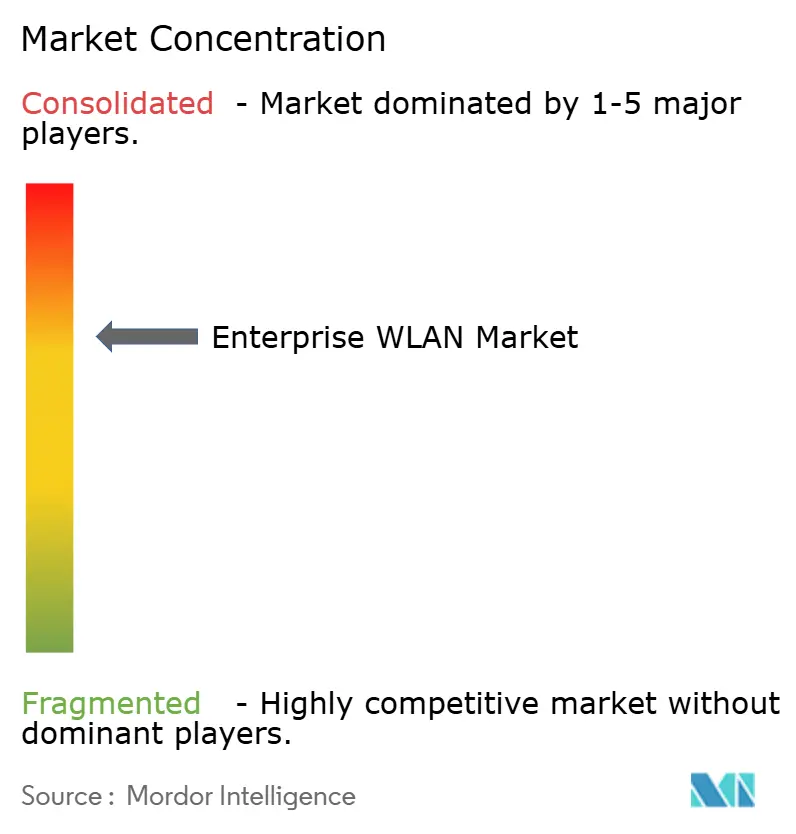
Recent Industry Developments
- May 2025: Extreme Networks unveiled ExtremeCloud Universal Zero Trust Network Access and Extreme Platform ONE, fusing networking and security into a single AI-powered control plane.
- April 2025: The U.S. Department of Justice intensified its legal challenge to HPE’s purchase of Juniper Networks, warning that innovation could suffer if two vendors control over 70% of the U.S. enterprise segment.
- March 2025: Cisco broadened its Wi-Fi 6E and Wi-Fi 7 portfolio, integrating AI-driven insights that simplify deployment in high-density campuses.
- February 2025: Fortinet added next-generation firewall functions into its AP series, offering unified threat protection without external appliances.
- January 2025: World Wide Technology released a comparative guide to Wi-Fi 7 access points, emphasizing the need for higher POE power budgets and improved in-ceiling cooling to sustain 4x4:4 tri-radio designs.
Research Methodology Framework and Report Scope
Market Definitions and Key Coverage
Our study defines the enterprise WLAN market as the annual revenues generated from hardware, software, and related managed or professional services that enable IEEE 802.11-based wireless local-area networks inside business, campus, and industrial premises. Revenues are counted at the point the solution is first invoiced to an enterprise customer, net of channel mark-ups but before any recurring subscription discounts.
Scope exclusion: Consumer-grade Wi-Fi routers, outdoor municipal hot-spots, and private 5G/CBRS small-cell systems are not considered.
Segmentation Overview
- By Component
- Hardware
- Access Points
- WLAN Controllers
- Wireless Hotspot Gateways
- Software
- WLAN Security
- WLAN Management
- WLAN Analytics
- Other Software
- Services
- Professional Services
- Managed Services
- Hardware
- By Organization Size
- Large Enterprises
- Small and Medium-sized Enterprises (SME)
- By End-user Vertical
- Banking, Financial Services and Insurance
- Healthcare
- Retail
- IT and Telecommunications
- Manufacturing
- Education
- Hospitality
- Other Verticals
- By Deployment Mode
- On-premises
- Cloud-managed
- By Geography
- North America
- United States
- Canada
- Mexico
- South America
- Argentina
- Brazil
- Rest of South America
- Europe
- United Kingdom
- Germany
- France
- Italy
- Rest of Europe
- Asia-Pacific
- China
- Japan
- South Korea
- India
- Rest of Asia Pacific
- Middle East and Africa
- United Arab Emirates
- Saudi Arabia
- South Africa
- Rest of Middle and Africa
- North America
Detailed Research Methodology and Data Validation
Primary Research
Mordor analysts interviewed network architects at leading system integrators, Wi-Fi chipset suppliers in North America, Europe, and APAC, as well as IT heads from healthcare, retail, and manufacturing enterprises. Discussions validated upgrade cycles, average selling prices, preferred deployment modes, and regional budget constraints that were not apparent in published data.
Desk Research
We began by aggregating publicly available indicators from tier-1 sources such as the Wi-Fi Alliance certification database, FCC and ETSI 6 GHz allocation filings, IEEE 802.11 task-group minutes, national customs shipment data, and enterprise ICT spending series released by the U.S. Bureau of Economic Analysis and Eurostat. Company 10-Ks and investor decks clarified vendor mix shifts, while news feeds from Dow Jones Factiva and financials on D&B Hoovers traced quarterly price and channel movements. Reports from trade associations like the Wireless Broadband Alliance supplied adoption ratios for Wi-Fi 6/6E. The sources listed illustrate our desk-work backbone; many additional references supported gap filling and fact checks.
Market-Sizing & Forecasting
A top-down construct starts with global vendor revenue reported for access points and controllers, which are then re-mapped to enterprise-only sales using channel splits and refurbished-gear deductions. Results are corroborated through selective bottom-up checks, sampled access-point shipments, prevailing ASP x volume for Wi-Fi 6/6E units, and service attach-rate surveys before final adjustment. Key variables tracked include: 1) quarterly access-point shipments, 2) Wi-Fi 6/6E/7 penetration rates, 3) average ASP movements, 4) enterprise IT capex growth, 5) cloud-managed WLAN uptake, and 6) BYOD workforce penetration. A multivariate regression links these drivers to historical revenue, generating the 2025-2030 forecast. Scenario analysis buffers macro volatility. Assumptions missing from bottom-up samples are bridged using median responses from our primary interviews.
Data Validation & Update Cycle
Outputs pass a two-step analyst peer review, variance checks against IDC tracker snapshots, and automatic flags for quarter-on-quarter deltas beyond two standard deviations. The model is refreshed annually, with interim updates triggered by material events such as a major spectrum release or mergers, ensuring clients always receive our latest view.
Why Mordor's Enterprise WLAN Baseline Commands Reliability
Published estimates often diverge because firms slice the market differently, apply unlike pricing assumptions, or freeze datasets for years.
Key gap drivers we observe include broader inclusion of outdoor carrier Wi-Fi in some studies, conservative versus aggressive ASP decline curves, and disparate refresh cadences. Mordor's scope confines revenues to enterprise indoor deployments, applies live FX conversion, and is updated every twelve months, which curbs vintage bias.
Benchmark comparison
| Market Size | Anonymized source | Primary gap driver |
|---|---|---|
| USD 24.86 B | Mordor Intelligence | |
| USD 35.26 B | Global Consultancy A | Includes carrier hot-spots and post-sale support contracts for five years |
| USD 7.42 B | Industry Association B | Uses street-price hardware only, excludes software and services |
| USD 24.90 B | Research Publisher C | Applies single blended ASP without regional weighting |
In sum, our disciplined variable selection, annual refresh, and dual-path validation give decision-makers a balanced, transparent baseline they can trace to concrete data points and easily replicate.
Key Questions Answered in the Report
What is the current size of the enterprise WLAN market?
The enterprise WLAN market size is USD 24.86 billion in 2025.
How fast is the enterprise WLAN market expected to grow?
It is forecast to expand at a 12.8% CAGR, reaching USD 45.40 billion by 2030.
Which region is growing the fastest for enterprise WLAN deployments?
Asia Pacific is projected to post a 13.5% CAGR between 2025 and 2030.
Why are cloud-managed WLAN platforms gaining popularity?
They eliminate onsite controllers, reduce total cost of ownership, and embed AI for automated troubleshooting, appealing to organizations with lean IT teams.
How does Wi-Fi 6E improve enterprise network performance?
It adds 1,200 MHz of 6 GHz spectrum, enabling wider channels, higher throughput, and lower latency, which are essential for video collaboration, IoT, and AR/VR applications.
What impact will HPE’s proposed acquisition of Juniper Networks have?
If approved, the combined entity could control over 70% of the United States enterprise-grade WLAN market, potentially changing competitive dynamics and accelerating AI-driven innovation.
Page last updated on:
